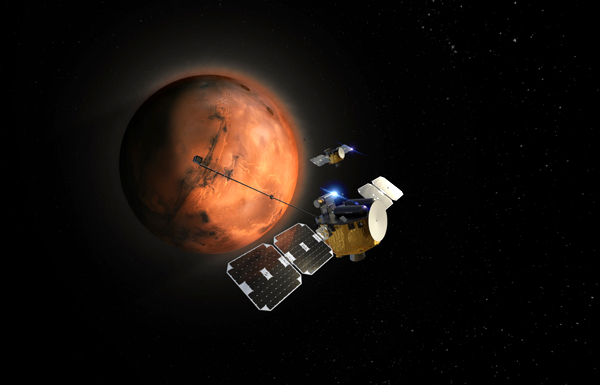 Astrobotic
Griffin-1 Mission Update (Press Release)
Griffin-1
Astrobotic
Griffin-1 Mission Update (Press Release)
Griffin-1 continues to gain momentum on the path to deliver Astrolab’s
FLIP (FLEX Lunar Innovation Platform) rover, Astrobotic’s own
CubeRover®, and several additional payloads to the Moon. Read on for updates on integration, payloads and software testing.
Propulsion Integration
Griffin-1’s propulsion architecture centers around four high-performance Composite Overwrapped Pressure Vessel
(COPV) propellant tanks engineered to be both lightweight and structurally robust, reliably containing substantial propellant loads at extreme operating pressures. Once the four propellant tanks are installed, final integration activities will be completed, and Griffin-1 will undergo environmental acceptance testing to ensure that the lander will endure the challenging environments of launch, space and the lunar surface.
Avionics Ready for Launch
In-house designed avionics flight hardware has been assembled and accepted for flight. These systems form the backbone of Griffin’s on-board control and telemetry, clearing a critical path towards spacecraft integration and ongoing system electrical testing. Designing, building and testing our avionics systems in-house enables the team to accelerate the development cycle, allowing for low-cost, rapid iterations that reduce risks and enhance performance.
Tighter control of this process also enables the team to design core products that are more easily adapted to future mission requirements, decreasing the cost and schedule for the next missions to space.
In tandem with flight-equivalent avionics, Astrobotic has implemented a fully closed-loop simulation of the descent and landing sequence. This system uses our custom LunaRay software to generate real-time images and 3D point clouds
(dense sets of spatial data points that represent the shape and features of the lunar surface). These are processed by our Terrain Relative Navigation
(TRN) and Hazard Detection & Avoidance
(HDA) systems, and are a vital step in validating our autonomous landing technologies for a GPS-denied environment.
Griffin-1 Manifest
Astrolab’s FLIP
(FLEX Lunar Innovation Platform) rover is undergoing developmental thermal vacuum testing, and core rover systems are integrated. Astrolab has individually tested key units and completed integrated functional testing of avionics, power and telecommunications. In addition, we have completed mobility and egress testing using the FLIP test platform.
Over the next several months, Astrolab will complete payload integration and vehicle-level protoqualification testing. The mission will demonstrate critical technologies—including telerobotic operations, lunar mobility, solar power generation and thermal resilience—that form the foundation of Astrolab’s larger
FLEX rover. In addition to commercial and government payload operations, Astrolab will conduct key experiments in mobility, perception, dust characterization, guidance and navigation, and communication.
BEACON‘s joint mission development with Astrobotic and Mission Control is well underway. A simulation has been completed on a Flatsat, a high-fidelity electrical copy of the rover used for testing. The rover has successfully connected and communicated with the Griffin lunar lander’s Flatsat.
This integrated simulation, which included CubeRover® operating with Mission Control’s Spacefarer™ software, is helping finalize the rover’s software ahead of its expected completion at the end of October.
All secondary payloads have been received and are undergoing final physical and functional checkouts on our Production FlatSat system, which supports end-to-end systems and software verification.
Structural Integration
Griffin’s core structure is nearing full integration. Pressurant tanks, ramps, attitude control thrusters and solar panels have all successfully undergone fit checks.
Looking Ahead
With engine qualification testing underway and critical systems coming online, Griffin-1 is advancing towards the Moon. Each milestone brings us closer to delivering payloads to the lunar surface, demonstrating precision landing, and advancing sustainable lunar infrastructure. The team is targeting the next viable launch window, which opens in July 2026.
Stay tuned for more mission updates as we near completion of Griffin-1 for the Moon and beyond.
Source: Astrobotic
****
 Astrobotic
Astrobotic
 Astrobotic
Astrobotic
 Astrolab
Astrolab

































